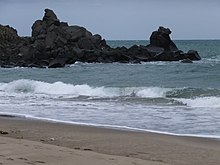Cape Fugui
| Cape Fugui | |
|---|---|
 Fuguijiao Lighthouse overlooking the point | |
 | |
| Location | , Shimen District, New Taipei City, Republic of China |
| Coordinates | 25°17′58″N 121°32′13″E / 25.2995°N 121.5369°ECoordinates: 25°17′58″N 121°32′13″E / 25.2995°N 121.5369°E |
| Designation | National park |
| Cape Fugui | |||
|---|---|---|---|
 Dapian Point (2015) | |||
| Chinese name | |||
| Traditional Chinese | 富貴角 | ||
| Postal | Fukwei | ||
| Literal meaning | transcription of Dutch hoek, meaning "cape" | ||
| |||
| Japanese name | |||
| Kanji | 富貴角 | ||
| Hiragana | ふうきかく | ||
| |||
| Cape Fugui Park | |||
|---|---|---|---|
 The rocky beach at Fugui Park (2013) | |||
| Traditional Chinese | 富貴角公園 | ||
| |||
Cape Fugui, Cape Fukwei, Fukwei Chiao, Fuguei Cape, or Fugui Cape[1] is the northernmost point on Taiwan. It is located in Cape Fugui Park near (老梅里, Lǎoméi Lǐ) in Shimen District in New Taipei.
Name[]
Fùguì is the pinyin romanization of the Mandarin pronunciation of its Chinese name 富貴角. These characters literally mean "rich and noble Cape" but actually transcribe the local Hokkien pronunciation Hù-kùi, used as a transliteration of the Dutch hoek ("hook; cape").[2]
In the 19th century, it was known as Foki during the period of Qing rule.[3] Under Japanese rule, it was known as Fūki Kaku from the Japanese pronunciation of the same characters. During Taiwan's brief official use of Tongyong Pinyin, it was known as Fuguei.[4]
Geography[]


Cape Fugui is the northernmost point of Formosa or Taiwan Island[3] and forms one end of Laomei Bay.[5]
The cape— under its Japanese name "Fuki Kaku"—forms part of the IHO's current definitions of the East[6][7] and South China Seas.[8] The still unapproved draft of the 4th edition of the Limits of Oceans and Seas amends the name to its pinyin form Fugui[7][9] but moves the boundary of the South China Sea from Fugui to Taiwan's southern cape Eluan.[10]
Cape Fugui is also considered part of the northern border of the Taiwan Strait.[9]
History[]
The Japanese administration erected a building on the cape in 1896[1] as the endpoint of an undersea cable.[11] It was destroyed during the Second World War. The present lighthouse was erected by the Taiwanese government in 1949[1] to help guide shipping and received its present black-and-white octagonal tower in 1962.[11] It was opened to the public in 2015, but entry is only permitted on the weekends as it remains an active radar station of the Taiwanese Air Force.[1]
Park[]
Cape Fugui or Fuguijiao Park surrounds the headland.[12] It includes a rocky beach with ventifacts (wind-shaped rocks)[12] and lush tropical vegetation.[1] There is a walking trail around the cape from Fuji Harbor (t 富基漁港, Fùjī Yúgǎng) to Laomei Village[12] and the brick Laomei Maze.[13][14] Old barracks from the Taiwanese armed forces have been converted into an arts center.[11] In September and October, the park forms part of Shimen District's kite festival.[12]
Transportation[]
The cape is about 26 kilometers (16 mi) along Provincial Highway 2.[1] It is sometimes inaccessible because of rockslides during heavy rain, as during June 2017.[15]
Gallery[]

The radar installation at Cape Fugui (2011)
The sunset over the Taiwan Strait at Fugui (2015)

Sightseers watching the sunset at Fugui (2015)
See also[]
- Cape Fugui Lighthouse
- Cape Eluanbi, the southernmost point on Taiwan
References[]
Citations[]
- ^ Jump up to: a b c d e f NTC (2019), "Fugui Cape".
- ^ Public sign, noted by Caltonhill (2012).
- ^ Jump up to: a b EB (1879), p. 415.
- ^ Caltonhill (2012).
- ^ NTC (2019), "Fugui Cape Lighthouse".
- ^ IHO (1953), §50.
- ^ Jump up to: a b IHO (1986), Ch. 7.3.
- ^ IHO (1953), §49.
- ^ Jump up to: a b IHO (1986), Ch. 7.2.
- ^ IHO (1986), Ch. 6.1.
- ^ Jump up to: a b c "Taiwan's Century-Old Fugueijiao Lighthouse Opened to the Public", Want China Times, 29 September 2015, archived from the original on 27 February 2012, retrieved 14 March 2019.
- ^ Jump up to: a b c d NTC (2019), "Fuguijiao Park".
- ^ NTC (2019), "Laomei Maze".
- ^ NTC (2019), "Awesome Positive Energy! A Guide to New Taipei City's 12 Attractions to Improve Your Luck".
- ^ NTC (2019), "Due to recent heavy rain...".
Bibliography[]
- , Encyclopaedia Britannica, 9th ed., Vol. IX, New York: Charles Scribner's Sons, 1879, pp. 415–17.
- S-23: Limits of Oceans and Seas (PDF) (3rd ed.), Monaco: International Hydrographic Organization, 1953, archived from the original (PDF) on 2011-10-08, retrieved 29 December 2020.
- S-23: Limits of Oceans and Seas (4th (draft) ed.), Monaco: International Hydrographic Organization, 1986, archived from the original on 2016-04-12, retrieved 2019-03-14.
- Official site, New Taipei City: Tourism and Travel Department, 2019.
- Caltonhill, Mark (4 May 2012), "富貴角 Fuguei Cape, New Taipei City", From Takow to Kaohsiung: Exploring Taiwan's History, Culture, and Languages through Its Place Names, Blogspot.
- Headlands of Taiwan
- National parks of Taiwan



